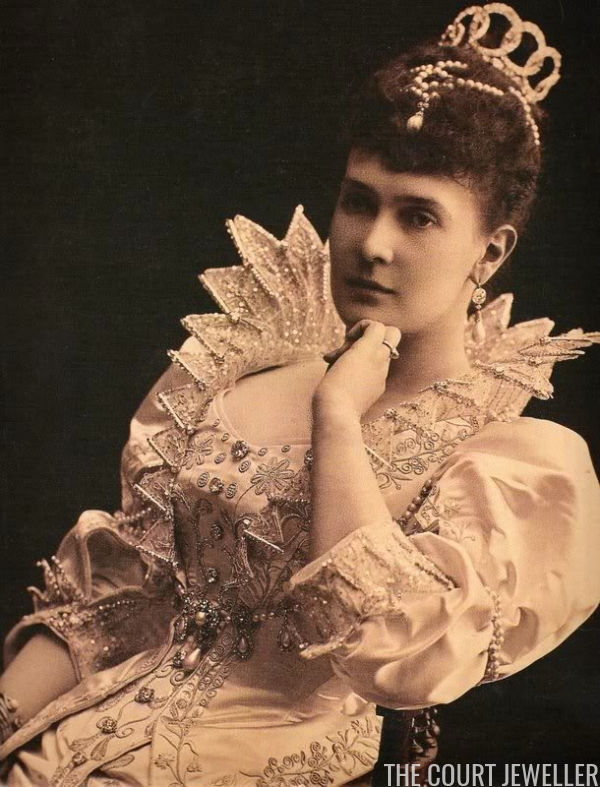 |
| The Vladimir Tiara (Photo: Grand Ladies Site) |
A Wedding Tiara for Eugenie?
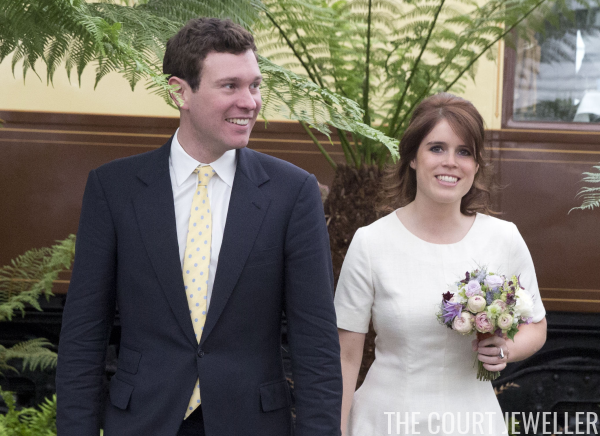 |
| Jack Brooksbank and Princess Eugenie attend the 2016 Chelsea Flower Show (Photo: Heathcliff O’Malley – WP Pool/Getty Images) |
Rumors are rife at the moment that an engagement announcement may be imminent for Princess Eugenie of York. Eugenie, who is eighth in line to the British throne, is an associate director at a London art gallery. She’s been in a relationship with Jack Brooksbank, who runs a nightclub in London, for six years.
This weekend, Camilla Tominey broke the news that Eugenie is planning to move to a cottage on the grounds of Kensington Palace ahead of a wedding to Jack in 2017. Though the Duchess of York swiftly denied the story, the move to KP has been widely reported, and Tominey has stood by her sources on the entire story.
If a royal wedding really is on the horizon, it’s time to start wagering on a wedding tiara, isn’t it? Regardless of the location or size of the guest list, each of the weddings in Eugenie’s royal generation so far — those of Peter Phillips, the Duke of Cambridge, and Zara Phillips — have featured brides wearing tiaras. Here are some of my early guesses for Eugenie’s bridal diadem…
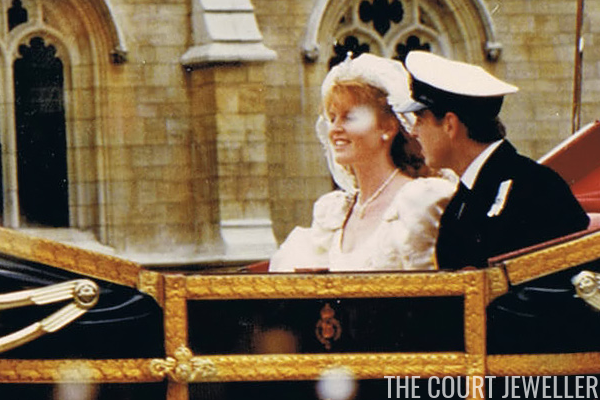 |
| The wedding of the Duke of York and Sarah, Duchess of York (Photo: Wikimedia Commons) |
The antique diamond tiara worn by Sarah Ferguson at her wedding to Prince Andrew in 1986 is likely still with the family. We know that Sarah kept it after their divorce, because she later wore it to white-tie events, including Elton John’s annual tiara ball. Eugenie is reportedly very close to both of her parents and has been a champion of their friendship post-divorce, so wearing her mother’s wedding tiara could be a way to honor their relationship and family on her own wedding day.
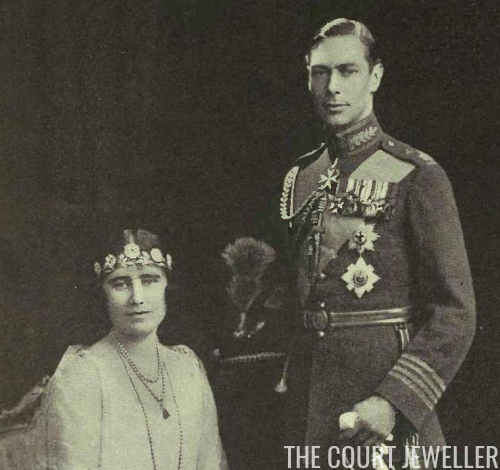 |
| The Duke and Duchess of York, later King George VI and Queen Elizabeth (Photo: Wikimedia Commons) |
Eugenie is often said to resemble her great-grandmother, the late Queen Mum, and I wouldn’t be surprised if she wore a tiara from the collection of her “Gan Gan” on her own wedding day. I think the Strathmore Rose, a lovely nineteenth-century diamond floral tiara, would suit Eugenie quite well. Although the Queen Mother usually wore the piece low across her brow, the tiara has a second frame that allows it to be worn more traditionally — perhaps with a bridal veil. (Read more about this tiara’s history over here!)
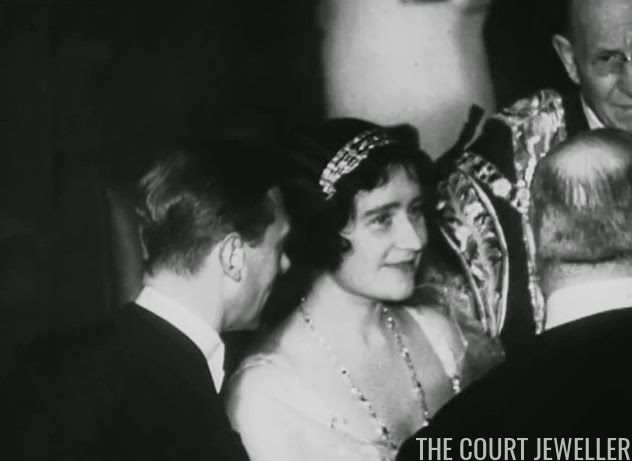 |
| King George VI and Queen Elizabeth (Photo: Screencap) |
If Eugenie goes for something less romantic and more geometric for a bridal ensemble, perhaps the art deco bandeau owned by the Queen Mum would fit the tiara bill? The Queen currently owns this piece, which is made of three bracelets set on a bandeau frame. We’ve only seen the Queen wear the bracelets in public, but I wouldn’t be surprised if the tiara frame is also still in the BP vaults. This tiara could go well with a bridal look that’s a little edgier but still vintage. (Read more on this tiara over here!)
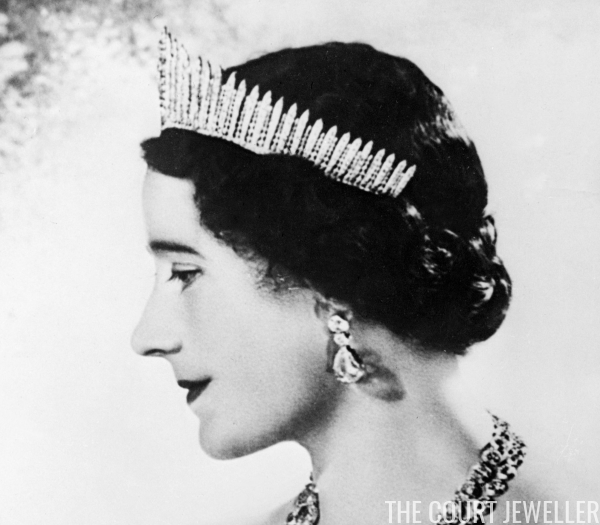 |
| Queen Elizabeth in her official coronation portrait (Photo: AFP/Getty Images) |
There’s another tiara from the Queen Mother’s collection with a more obvious bridal history: the diamond fringe tiara commissioned by Queen Mary. It was worn by the Queen on her wedding day in 1947, and Princess Anne also borrowed it for her first wedding in 1973. I love a good diamond fringe on bride — when worn correctly, they make her look like she’s a shimmering ray of sunlight. (Read more about this tiara over here!)
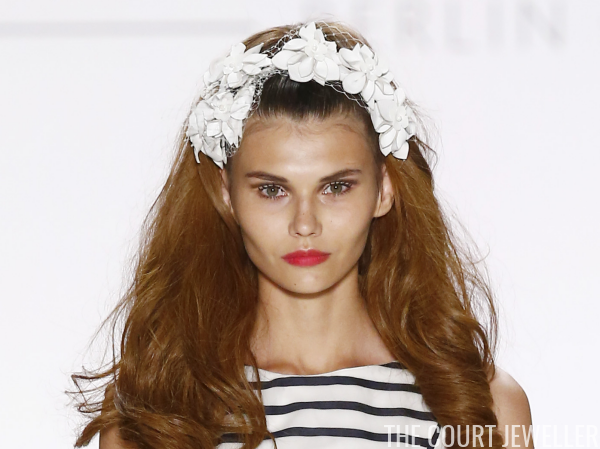 |
| A runway model wears a flower crown in Berlin, June 2016 (Photo: Peter Michael Dills/Getty Images for IMG) |
When Eugenie’s parents married, her mother famously arrived at Westminster Abbey wearing a bright crown of flowers. Her tiara was hidden underneath the blossoms and was only revealed after the marriage certificate was signed and she was officially a princess. Flower crowns are back in vogue, especially with Eugenie’s generation, so perhaps we’ll see her honor both trend and family tradition by eschewing gemstones altogether and donning a crown of flowers instead?
Jewel History: Russian Art Show (1935)
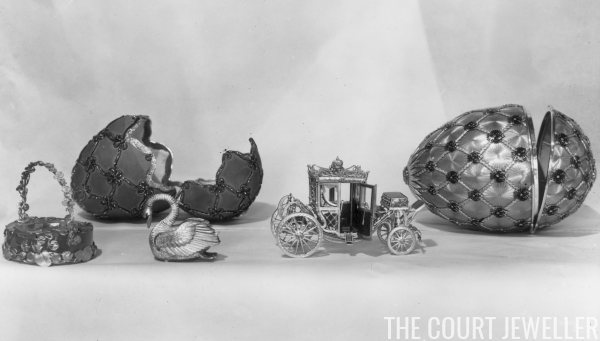 |
| Two Faberge Easter eggs on display at the 1935 Russian art exhibition in Belgrave Square (Photo: Topical Press Agency/Getty Images) |
The last pathetic relics of the luxury and splendour with which the pre-war Russian aristocracy loved to surround itself were recently on view at No. 1 Belgrave Square — just two doors away from the residence of the Duke and Duchess of Kent [1], writes a London correspondent. Because of her Tsarist ancestry [2], the Duchess was called upon to perform the opening ceremony and make her first official speech in England since her marriage. This was one of the shortest on record. She simply smiled and said: “I have much pleasure in declaring the Exhibition open.”
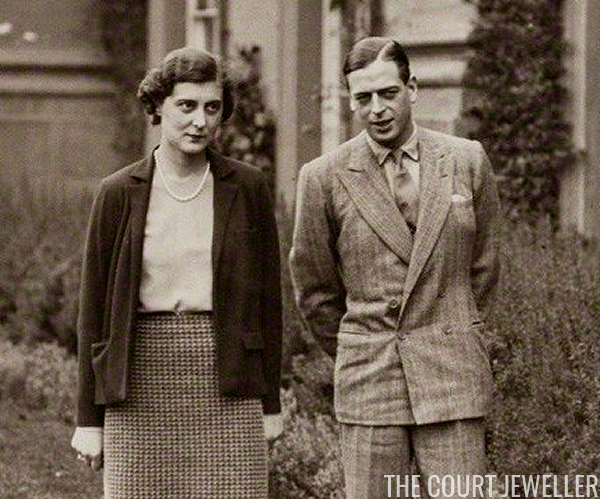 |
| The Duke and Duchess of Kent, ca. 1934 (Photo: Wikimedia Commons) |
The Duchess made the rounds of the spacious rooms, filled with the ikons, the priceless jewels, the bibelots, the pictures and rich embroidered stuffs which White Russians, flying for their lives, managed to smuggle out of the country before the Bolshevist regime took over. She gazed at the magnificent — almost flamboyant — tiara of sapphires and diamonds, now the property of Queen Marie of Romania [3]. The sapphires, as big as pigeons’ eggs, almost dwarfed diamonds of such size and splendour that alone they would have made a rare and wonderful blaze of light.
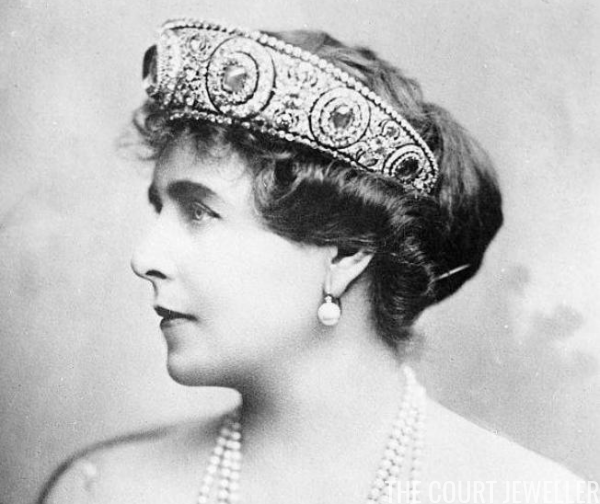 |
| Queen Marie of Romania wears Grand Duchess Vladimir’s sapphire kokoshnik (Photo: Grand Ladies Site) |
This originally belonged to her grandmother, the Grand Duchess Vladimir, whose collection of jewels was famous, even amid the barbaric ostentation of pre-war Russia. So that they might never be shut away from her gaze, this Grand Duchess had glass cases all round her bedroom, in which her jewels were displayed.
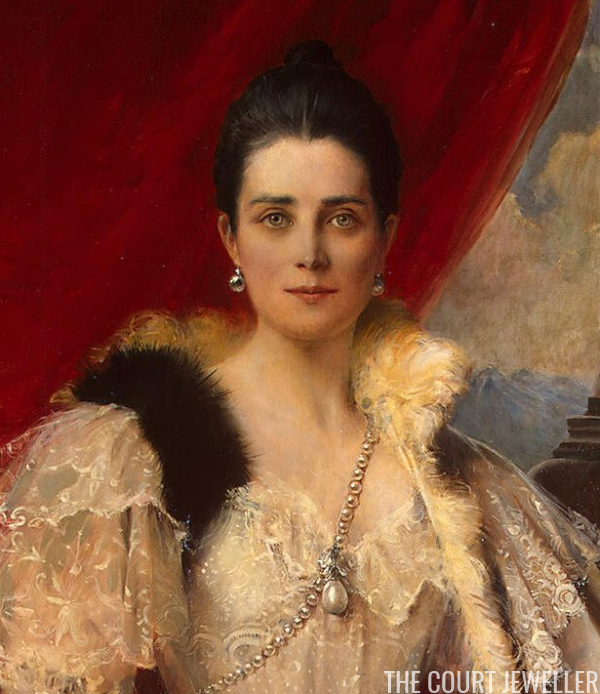 |
| Flameng’s 1894 portrait of Princess Zinaida Yusupopva wearing the “La Pelegrina” pearl (Image: Wikimedia Commons) |
Among the jewels there are six exhibits worth 100,000. One pear-shaped pearl [4], which tradition declares to be the pair to that dissolved in wine by Cleopatra, is literally priceless. It is regarded as so valuable that no price can be placed upon it. Once owned by Philip II of Spain, and by Louis XVI of France, it came into the possession of Princess Tatiana Yusupova in 1826, and still remains in the Yusupov family. An enormous spray of diamonds and turquoises, representing a loose bunch of cornflowers, drew envious glances from all women present; and so did the necklace of sapphires and diamonds, with a pointed diamond fringe.
Perhaps the most enchanting section of all was that devoted to the work of Faberge, the famous jeweller of French descent who won favour at the court of Tsar Nicholas II, because of his ingenuity in devising the most extravagantly beautiful little toys and bibelots. Many of those which survived the downfall of Russia are now the property of Queen Mary, who delights also in their exquisite workmanship. There was a little crowd of women around the miniature jade piano [5], for instance, with its tiny ivory keys, and lid that opens and shuts perfectly. Then Faberge excelled in the production of Easter eggs; and for each of the great Russian Easter festivals, he used to think of some new idea to please the Tsar.
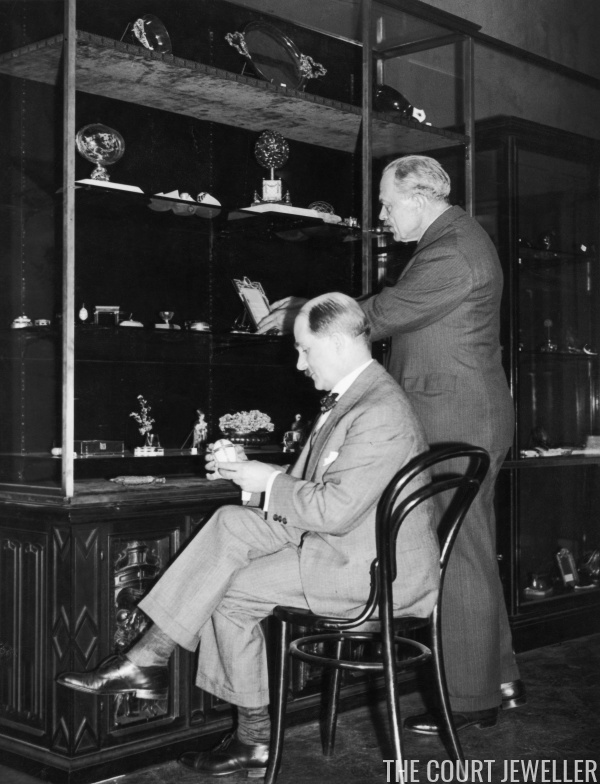 |
| Agathon Faberge, son of Carl Faberge, sits as he helps to arrange the Belgrave Square exhibition of 1935 alongside H.C. Bainbridge (Photo: Topical Press Agency/Hulton Archive/Getty Images) |
One was in the form of a bay tree, its leaves of fine jade and spangled with diamond and amethyst. This was placed on a plinth of jade and diamonds, surrounded by posts and chains of the same precious stones. Within, there was a tiny diamond bird which popped out and sang, upon pressing a secret spring. One of the charms of these extravagant toys of Faberge was that they all worked.
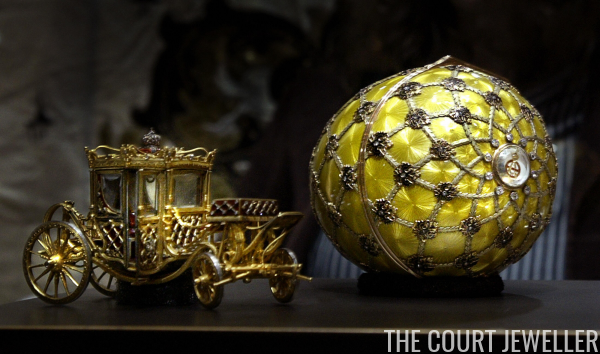 |
| The Coronation Egg on display at the Kremlin in Moscow in 2004 (Photo: YURI KADOBNOV/AFP/Getty Images) |
Then there was the Easter egg of pink enamel, covered all over with lily-of-the-valley blossoms in pearls and diamonds, which had tiny flaps in its sides, revealing miniatures of the Tsar and the two Grand Duchesses. One of gold and yellow enamel contained a tiny model of the imperial coronation coach in gold, and carried out with a wealth of painstaking detail. An egg of rock crystal held within its transparent depths a graceful golden tree, as well as a mechanical peacock in rich blue and green enamel.
NOTES
1. Prince George, Duke of Kent (1902-1942) and Princess Marina, Duchess of Kent (1906-1968). George was the fourth son of King George V and Queen Mary of the United Kingdom; Marina was the youngest daughter of Prince and Princess Nicholas of Greece and Denmark. George and Marina married in November 1934 and established a home at No. 3, Belgrave Square. Their first two children, Edward and Alexandra, were born at No. 3.
2. Marina’s mother, Princess Nicholas, was born Grand Duchess Elena Vladimirovna of Russia, the only daughter of Grand Duke Vladimir Alexandrovich (a son of Tsar Alexander II) and Grand Duchess Maria Pavlovna (better known to history as Grand Duchess Vladimir). Moreover, Marina’s paternal grandmother was Queen Olga of Greece, who was born Grand Duchess Olga Constantinovna of Russia; she was a granddaughter of Tsar Nicholas I.
3. You can read much more about the sapphire kokoshnik made by Cartier for Grand Duchess Vladimir (and later purchased by Queen Marie of Romania) in our post over here!
4. This is the pearl known as “La Pelegrina” (not to be confused with the more famous “La Peregrina”). The Cleopatra story is a bit of fantasy, because La Pelegrina was discovered in Central America in the 16th century. King Philip IV of Spain gave it to his daughter, Princess Maria Theresa, when she married King Louis XIV of France in 1660. By 1826, the pearl was in the collection of Princess Tatiana Yusupova, the wife of a Russian nobleman and a lady-in-waiting to Tsarina Alexandra Feodorovna (wife of Tsar Nicholas I). The pearl then passed to Tatiana’s daughter, Princess Zinaida Yusupova, and her grandson, Prince Felix Yusupov (best known as one of the assassins of Rasputin). Felix sold the pearl in the 1950s.
5. Queen Mary purchased the miniature jade piano between 1922 and 1931. You can read more about the piece at the Royal Collection website.
- « Previous Page
- 1
- …
- 618
- 619
- 620
- 621
- 622
- …
- 857
- Next Page »